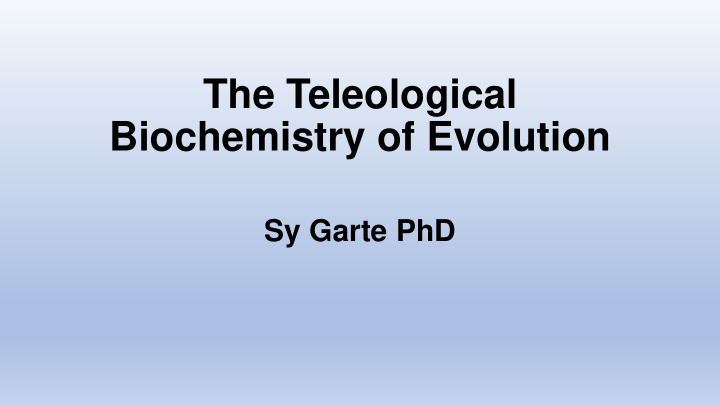



The Teleological Biochemistry of Evolution Sy Garte PhD
Teleology and Teleonomy • Teleology is the philosophical attempt to describe things in terms of their apparent purpose, directive principle, or goal. • The philosophical interpretation of natural phenomena as purpose or design. • The doctrine that final causes exist. • Teleonomy describes a process that owes it goal- directedness to the operation of a program (Mayr, Monod)
Anti-Teleology in Biology “I don’t see any reason to try to smuggle the notion of purpose into a purely materialistic process… A blind material process, which acts simply according to the laws of physics, has no being behind it, no “mind” directing it. That, to me, is what indicates a purpose.” J. Coyne “Teleological notions are among the main obstacles to theory formation in biology.” K. Lagerspetz “Evolutionary theory did away with teleology, and that is that.” D. Hull
Teleological Language in Biology “Teleology is like a mistress to a biologist: he cannot live without her but he’s unwilling to be seen with her in public.” JBS Haldane “Teleological thinking has been steadfastly resisted by modern biology. And yet, in nearly every area of research biologists are hard pressed to find language that does not impute purposiveness to living forms.” T. Lenoir “ ‘A turtle came ashore to lay her eggs’… There is now complete consensus among biologists that the “teleological” phrasing of such a statement does not imply any conflict with physicochemical causality.” E. Mayr
Biological Teleology (Teleonomy) Is Real “The biosphere is utterly saturated with design, with purpose, with reasons.“ D. Dennett “The elimination of teleology is often presented as a virtue. In fact it is an unnecessary restriction.” D. Noble “natural selection… never commits itself to a future goal.” E. Mayr
The Non-Conservation Principle (NCP) of Biology • All forms of matter and energy obey the law of conservation, including life. • But life is not conserved. All creatures die. • The NCP is necessary and sufficient for natural selection. • Natural selection imposes a purpose on all biological creatures, which is to achieve, by random variation, maximum fitness. • The mechanism by which biological populations achieve this goal is the biochemical process of evolution.
Teleonomy and Translation The key to Darwinian evolution is the tight linkage between inheritable genotype and the phenotype , which is the target of selection. This linkage is provided by the biochemical translation of a nucleic acid- based genetic code into a set of protein structures with specific catalytic activities (enzymes). Hypothesis: Teleonomic evolution derives from the biochemistry of translation. The process of protein synthesis according to a genetic code is goal-directed, and the source of purpose in all of life.
THE EVOLUTIONARY MECHANISTIC CYCLE DNA/GENOTYPE Heredity Biochemistry Natural Selection PROTEINS PHENOTYPE ENVIRONMENT
Biochemistry of Evolution is DNA-Directed Protein Synthesis (Translation) DNA PROTEINS Nucleic Acid Chemistry Amino Acid Chemistry 1. mRNA (with codons from DNA) 2. tRNAs (with anti-codon & AA binding site) 3. Aminoacyl-tRNA Synthetases (with AA and tRNA binding sites) 4. Ribosome (with lots of stuff) 5. Etc.
Aminoacyl-tRNA Synthetase (aaRS)
Putting the right amino acid on the right tRNA
AA tRNA Synthetases have an editing site
AA tRNA Synthetases have a purpose • Bind correct amino acid and activate with ATP • Bind several cognate tRNAs, based on shape and anti-codons • Edit amino acids to ensure specificity • Attach amino acid to tRNA • Each Synthetase uses a different strategy
Teleological language is needed to describe the actions of AA tRNA Synthetases “As a consequence, enzymes facing this problem have evolved a second active site…These constraints have guided the evolution of enzymes involved in information transfer to reach optimum ratios of accuracy and speed. How do synthetases deal with this?” Current Biology 15, 536-40 2005 “Several mechanisms working together ensure that the tRNA synthetase links the correct amino acid to each tRNA. Alberts et al. Molecular Biology of the Cell
All Enzymes exhibit Teleonomy Unlike non-biological catalysts, enzymes are: 1. Extremely specific, catalyzing one reaction involving a single set of reactants 2. Extremely efficient, reaching reaction rates 10 5 or more times basal rates 3. Participate in complex control and feedback mechanisms 4. Include all required energy conversion mechanisms to drive reactions 5. Are produced only when needed
What is the Source of Teleonomy in Evolution? “It obscures definitions to combine current functioning and history of origin in a single explanation”. Mayr The existence of purposeful behavior in the current functioning of AA tRNA Synthetases (and other enzymes) is undeniable. The history of origin is unknown. (Unknowable?) 1. Part of the chemical, naturalistic abiogenesis of life, by a more primitive form of evolution. 2. Part of the Creation of Life by a Creator
THANK YOU Supported by a grant from the John Templeton Foundation Thanks to: • Aniko Albert • Mark Meredith • Randy Isaac • Kevin Arnold
THE GENOTYPE-PHENOTYPE CYCLE
Recommend
More recommend